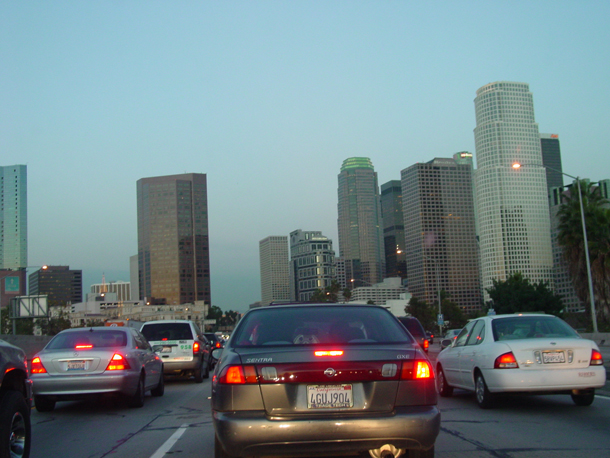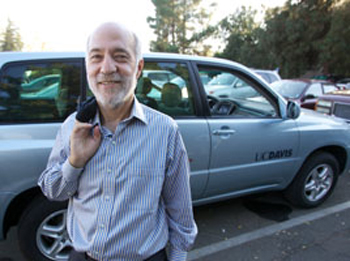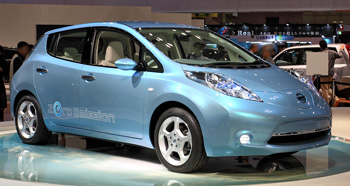Keeping Emissions Down in California
Air Date: Week of July 13, 2012
 |
The California Air Resources Board has mandated that by 2025, 15 percent of new cars sold in the state must have zero or near-zero emissions. Daniel Sperling, the director of the Institute of Transportation Studies at the University of California Davis, tells host Bruce Gellerman how the state is going to achieve this goal.
Transcript
GELLERMAN: From the Jennifer and Ted Stanley Studios in Somerville Massachusetts, this is a recycled edition of Living on Earth. I’m Bruce Gellerman. California has been crazy about cars for a long time. Now some are saying the state’s new auto emission and fuel standards take crazy to a whole new level. Professor Daniel Sperling is one of nine members on the California Air Resources Board. Last December the board unanimously approved strict standards limiting the amount of carbon in vehicle fuels.
SPERLING: So, really it is a big change. What it does is requires the oil companies to reduce the carbon in their fuel that they sell by ten percent by 2020. And that, perhaps, doesn’t sound like a big number, but to get that ten percent means probably about a third of their fuel has to be shifted away from petroleum.
And I have to say, myself as an academic, myself as a regulator, I don’t know how this is going to play out exactly. And that’s why these policies we’re talking about are performance-based and market-based. We’re leaving it to the market and consumers and industry to figure it out. A lot of that will be biofuel, some of it will be electricity, some of it will be natural gas. We’re talking about a transformation, a revolution here. And it’s really remarkable.
GELLERMAN: Well, not content with just that revolution, California's Air Resources Board is putting the pedal to the metal and requiring that, by 2025, 15 percent of new car sales in the state be either zero, or near-zero emission vehicles. Here again is Professor Dan Sperling.

Professor Daniel Sperling. (Photo: Daniel Sperling)
SPERLING: California is once again, for better or for worse, you know, plunging forward ahead of everyone else and we’re not telling companies exactly what technologies to use, but we’re expecting that of those vehicles, probably about a third to a half would be hydrogen fuel cell vehicles, a third to a half would be battery electric vehicles, and the rest would be plug-in hybrid electric vehicles.
GELLERMAN: But of course, there are very few hydrogen gas stations now.
SPERLING: That’s right. There are probably about ten or so in California right now. And battery electric vehicles are a very important part of it. But there’s some real issues with battery electric vehicles, whether they really will be fully accepted: there’s the range issue, the cost of batteries, so there’s a lot of people that believe that hydrogen fuel cell vehicles will ultimately be at least, if not more, important and dominant than battery electric vehicles.
GELLERMAN: Now, back in the 1990s, California did mandate that carmakers produce a certain amount of zero emissions fuel vehicles, and - well, let's be generous - that didn't work the way you had hoped.
SPERLING: That is being generous.
GELLERMAN: (Laughs.)
SPERLING: But this is the same policy, the same rule. And it did start in 1990. It turned out that the technology didn’t advance as fast as we thought, that batteries were more expensive than we anticipated they would be, the improvements were slower than we anticipated, and so, frankly, it did become a problem. The good news is that now, thanks in part to, you know - one of the benefits, one of the impacts of that zero emission vehicle program over the years is - it did motivate the car companies to really focus on electric vehicle technologies.
And even though it wasn’t successful in getting a lot of vehicles out there - they did invest a lot in developing the technology. And it is what spurred Toyota to start with the Prius and the hybrid vehicles. And so, it’s all part of the same path and now with Nissan and General Motors making major commitments to electric vehicles, and with all the other car companies all ready to launch electric vehicles - we’re on that path now.
GELLERMAN: Could one of the reasons that these car makers are behind this be because the average cost of a car is going to go up almost $2,000 and that they’re going to come out, well, flush?
SPERLING: There certainly has been a dramatic turn-around in the attitude of the automobile industry in the last few years. They see that this is inevitable, that there is a problem with oil, and even more important, there is a problem with climate change.
You know, I’m on leave now in Washington DC, and I’m hanging out here - and I see how the politics have been poisoned here about climate change, you can't even talk about climate change, but that doesn’t reflect reality in industry or in a lot of other places.
The car industry, across the board, is fully acknowledging and accepting that climate change is real and something has to be done about it - that they can make the vehicles much more efficient, and that we’re moving toward electric drive technology with batteries and fuel cells. So I think there’s now a full acknowledgement that this is necessary, this is going to happen. And instead of fighting it, they have a lot more to gain by being part of the solution than part of the problem.
GELLERMAN: Yeah, we should say, though, that if you have an electric car, and you’re generating that electric energy by burning coal, that’s not a zero emissions car, it’s just not coming out of the tailpipe, it’s coming out of the smokestack.
SPERLING: Absolutely. And so part of this pathway toward electric drive vehicles is making sure that the electricity grid is cleaned up as well. And in the United States on average, about half of the electricity is coming from coal but that percentage is coming down. And there are almost probably, I think, three quarters of the states in the U.S. already have programs to introduce more renewable energy. In California the requirement is that 33 percent of the electricity must be renewable electricity by 2020 and most of the rest is nuclear and natural gas. So the emissions are very low in California, and they’re coming down everywhere.

The Nissan Leaf. (Photo: Wikipedia Creative Commons, Tennen-Gas)
GELLERMAN: As I understand the California decision - if I am in Massachusetts and I buy one of these vehicles, it counts towards California’s goal.
SPERLING: That’s a very good point. So that when we say the California program, it’s really California and ten other states - ten other states have agreed to adopt whatever California adopts. And so what we are launching here is a revolution, and ideally, hopefully, the federal government will gradually come to embrace these same requirements, but even if they don’t we’re going to see all of the car companies introducing this technology, not just in those ten states, but across the country.
GELLERMAN: What about me? How am I going to fare in terms of my pocket book in these rules and standards?
SPERLING: Well, in the end, consumers should come out ahead. In fact, in some of these rules, they come out ahead immediately. With the vehicle rules, the cost analyses that we’ve done suggest that by 2025, the average vehicle will cost about $2,000 more than today but they will be so much efficient that over that time, they will save $6,000 in reduced fuel costs from here to there. And so the result of that is that the average consumer comes out ahead. And because the average consumer also takes out a loan on their car, for instance a five-year loan, from day one, you will be saving money on your car because the increase in your car payment will be less than the amount of fuel savings that you get.
GELLERMAN: Daniel Sperling is director of Institute of Transportation Studies at the University of California Davis and a member of the California Air Resources Board. Professor Sperling, thank you so very much!
SPERLING: It's a pleasure.
Links
Living on Earth wants to hear from you!
Living on Earth
62 Calef Highway, Suite 212
Lee, NH 03861
Telephone: 617-287-4121
E-mail: comments@loe.org
Newsletter [Click here]
Donate to Living on Earth!
Living on Earth is an independent media program and relies entirely on contributions from listeners and institutions supporting public service. Please donate now to preserve an independent environmental voice.
NewsletterLiving on Earth offers a weekly delivery of the show's rundown to your mailbox. Sign up for our newsletter today!
 Sailors For The Sea: Be the change you want to sea.
Sailors For The Sea: Be the change you want to sea.
 The Grantham Foundation for the Protection of the Environment: Committed to protecting and improving the health of the global environment.
The Grantham Foundation for the Protection of the Environment: Committed to protecting and improving the health of the global environment.
 Contribute to Living on Earth and receive, as our gift to you, an archival print of one of Mark Seth Lender's extraordinary wildlife photographs. Follow the link to see Mark's current collection of photographs.
Contribute to Living on Earth and receive, as our gift to you, an archival print of one of Mark Seth Lender's extraordinary wildlife photographs. Follow the link to see Mark's current collection of photographs.
 Buy a signed copy of Mark Seth Lender's book Smeagull the Seagull & support Living on Earth
Buy a signed copy of Mark Seth Lender's book Smeagull the Seagull & support Living on Earth

